
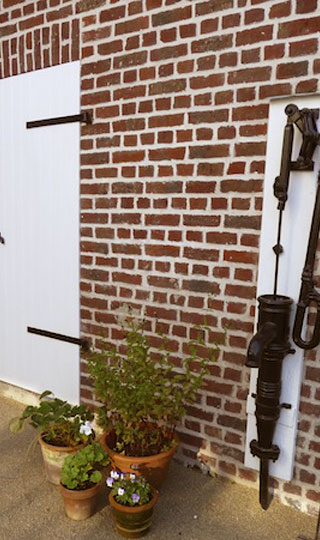
Repointing is the process of carefully removing deteriorated mortar from the joints of a masonry wall and replacing it with new mortar that has been intelligently formulated. Repointing will protect the building and enhance its historical character. Improperly done, repointing not only detracts from the appearance of the wall, but may cause damage to the historic masonry units themselves.
If an inappropriate mortar mix is used, rather than preserving the wall, it will actually accelerate the rate at which the masonry deteriorates. Knowing the performance characteristics and ingredients of the original mortar is the best place to start. After we analyse your mortar, we will mix a mortar recipe that appropriately matches the original building and not only look good, but will stand the test of time.
As one of the UK's leading specialists in lime mortar pointing, Heritage Brickwork Restoration will sample, test and match to the original mortar for pointing using traditional methods. Repairing brickwork where necessary in sympathy with the original work.
Heritage Brickwork Restoration have a family heritage built on historic brickwork. Their qualified craftsmen trained by Dr Gerard Lynch, the world renowned brickwork historian, are experienced in all aspects of historic brickwork and its conservation using traditional cleaning methods to restore brickwork and stonework to its original natural beauty.
Below are a selection of pointing styles used for historic brickwork. Heritage Brickwork Restoration can repoint historic buildings with these traditional styles, as well as using these historic methods on new buildings to give them a classic look.
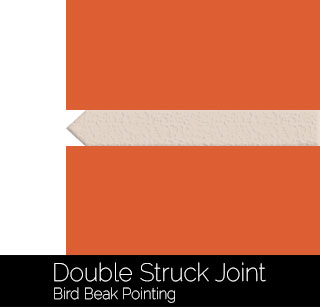
Also known as Bird Beak Pointing, this historical finish was developed in the Tudor Period from C15th to the C16th and was employed largely to overcome the irregularity of bricks in this period. The finish was created by using a pointing trowel, angled from the top of the joint to the middle firstly, and then from the bottom to the middle, slightly recessed. This finish is sometimes referred to as birds beak.
‡ For a quote on repointing in a Double Struck / Bird Beak Style click here ‡
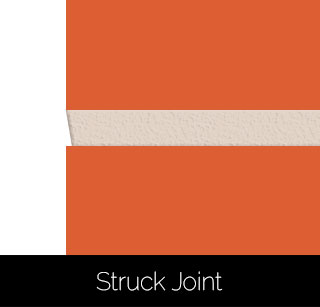
Also sometimes known as Overhand Struck. This joint finish was developed in the early part of the 17th Century, and although not considered to be a good external joint, it had its place at a time when brick manufacture was reasonably poor and bricks were irregular shaped. It would help to define a straight line on the top arise of the brick.
‡ - For a quote on repointing in a Struck / Overhand Struck Style click here -
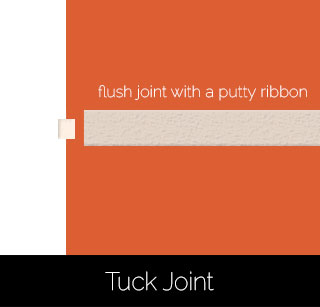
Developed in the late C17th and often referred to as Trompe l'oiel, which translates from the French to 'trick of the eye'. This style of pointing was designed to imitate rubbed and gauged brickwork, often using cheaper bricks. The joints would be filled with a mortar coloured to match the brickwork, this was done to hide any irregularities. A line would be scribed and ribbons of a fine lime putty would be laid into the grooves to give the effect of approximately a 5mm joint.
‡ For a quote on repointing in a Tuck Pointed Style click here ‡
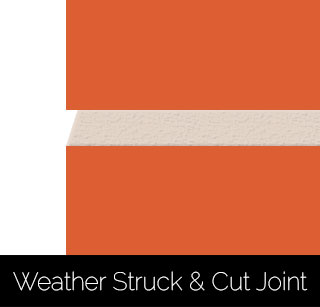
This type of finish became very popular in the late C19th when bricks became much more uniform. The profile of this joint was designed to help shed water away from the brickwork. It was created by using a trowel at an angle, sloped downwards and cut at the bottom using a Frenchman knife to give a defined straight line.
‡ For a quote on repointing in a Weather Struck & Cut Pointing Style click here ‡
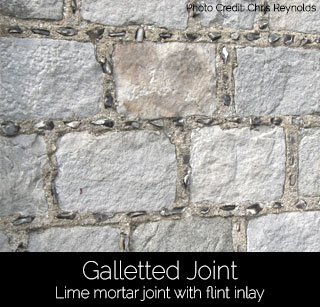
This type of Galleted finish is seen mainly on historical stone built structures such as Castles, Churches and old walls but is also found on some stone built houses. The Gallating joint uses a lime mortar that has small pieces of flint pushed into it to create a dotted pattern. The use of flint in the joint has many benefits other than its aesthetic appeal, it adds strength to the joint whilst using less mortar and helps prevent the mortar from further shrinking whilst setting.
‡ For a quote on repointing in a Galletted Pointing Style click here ‡
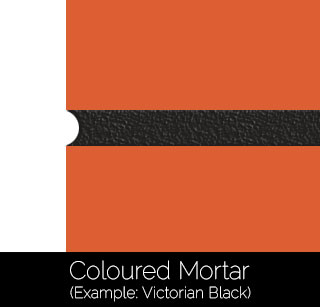
Using coloured mortar goes as far back as the Roman times where different types of sandy Volcanic ash would be added to slaked lime, this would create hydraulic lime ready to build with. The colours back then were limited to white, grey, black and red, however with todays technology a mortar of any colour is possible using a range of coloured pigments and minerals.
With so many different types of coloured pigments and gauges of mortar to work with, it is absolutely paramount to match existing mortar for a perfect repair. The best way to get a perfect match is for Heritage Brickwork Restoration to analyse the existing mortar and then create a test panel alongside the original brickwork.
In some cases the original pointing may be so old and weather damaged that the entire building will need repointing. Even in these circumstances the mortar colour can be closely matched to it's original colour, and created using traditional methods and custom lime mortars.

Lime mortar with it's renowned longevity is in many ways a superior product to cement. It allows water to be evaporated from it therefore self-sealing any tiny holes and thus keeping the inner walls dry. If you have a property that is pointed using lime then it is crucial that it is repaired in a lime mortar and never cement. Cement aggresively repels water from absorbtion, with old buildings the cement would simply drive the water into the aged bricks and damage all the brickwork severly.
As one of Kent's leading Lime Mortar Specialists we can repair full structures, supply custom mortar mixes to match existing brickwork and also supply bulk mixes for entire repoints.


